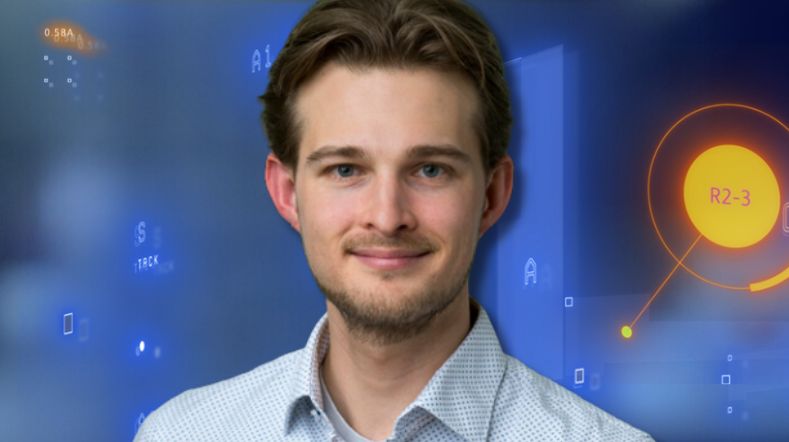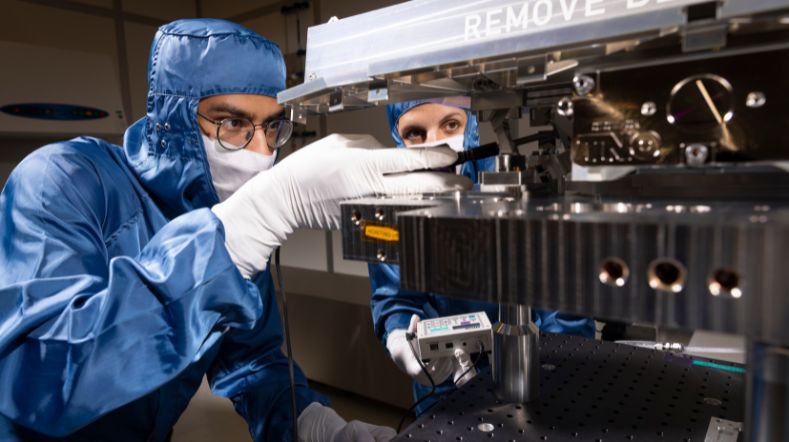
With this technology, the LISA space mission will search for gravitational waves from black holes
The European Space Agency (ESA) is currently preparing for a special mission: the Laser Interferometer Space Antenna, or LISA. LISA will be the first space-based detector to measure gravitational waves in space with extreme accuracy. ESA is expected to take an official decision in early 2024 on the actual construction of the mission and on whether all the necessary technological developments have reached a sufficiently advanced stage to make it possible. TNO has developed crucial laser-pointing technology for this mission and was the first party to be evaluated by and receive a positive assessment from ESA this year. The Netherlands Space Office recently decided to provide funding to TNO to enable it to supply the mechanism incorporating this technology as a test model to the international LISA consortium: the Point Ahead Angle Mechanism (PAAM).
Einstein was right
Astronomers use gravitational waves to observe events in the universe, such as collisions between stellar black holes or neutron stars. Gravitational waves are ripples in spacetime created when massive objects, such as black holes, collide. Scientists have only been able to directly measure gravitational waves since 2015. They managed to do this for the first time in September 2015 using the Earth-based detector LIGO. These measurements made clear that Albert Einstein was right when he published his theory of waves in spacetime in 1916.
However, observatories on Earth can only observe gravitational waves with lengths of up to around 10,000 kilometres. For this reason, collisions between supermassive black holes, for example, remain invisible. Measuring the longer wavelengths requires a detector much larger than anything that can be built on Earth. That is why LISA will be space-based.
LISA
The gravitational wave detector LISA will consist of three unmanned spacecraft that will fly in a triangular formation in the same orbit around the sun as Earth, but some 50 million kilometres behind it. Their relative positions will be measured using laser interferometry, which will be necessary to measure the minute variations in position caused by passing gravitational waves. The three spacecraft will fly through space 2.5 million kilometres apart.
Highly sophisticated laser-pointing technology
As part of the technological developments required to realise LISA, TNO has focused on developing a mechanism capable of pointing laser beams with extreme accuracy.

'Each of the three spacecraft will have its own laser and the mechanism developed by TNO can point the laser beam with such accuracy that the light will reach the other spacecraft with precision over a distance of 2.5 million kilometres. This level of precision means that someone in Groningen would be able to point out a fly on the Euromast in Rotterdam. So we are talking about highly sophisticated technology,'
ESA gives PAAM positive assessment
In preparation for the decision that ESA intends to make in early 2024 to actually start construction of the LISA mission, ESA is assessing all crucial technologies in 2023. ESA is in charge of the overall preparation and realisation of the LISA mission, but is collaborating with NASA and an international consortium of scientists: the LISA consortium. All these parties are developing technology to make the LISA mission possible.
TNO’s laser-pointing technology was the first to be assessed by ESA, because the development of this technology started early and it was ready for assessment first. ESA’s verdict was extremely positive, which means that TNO’s PAAM mechanism is likely to be the product that will be used in LISA in the future. 'We have developed a mechanism roughly the size of a matchbox. So we’re only talking about a small part of LISA. But a very important part,' Marée says.
Netherlands Space Office invests
The Netherlands Space Office (NSO) therefore recently decided to provide further financial support to TNO with a budget that the Ministry of Education, Culture and Science has made available for the development of scientific space instruments. This will allow further testing of the current prototype in relation to radiation and vibration loads. These tests will make it possible to demonstrate that the PAAM can survive the launch and the harsh conditions of space. TNO will also be collaborating with research organisation SRON, which is working on the electronics to control the TNO mechanism. Eventually, the PAAM mechanism will be transferred to the LISA consortium for further integration into the LISA detector test model.
Dutch interest
Within the LISA NL consortium TNO is collaborating with Dutch scientists and the Foundation for Dutch Scientific Research (NWO) institutes Nikhef and SRON (LISA-NL). Alongside TNO’s work to develop the PAAM, SRON and Nikhef are working together on the development of the photodiodes for LISA (LISA’s 'eyes’) and SRON is developing the Mechanism Control Unit that will control all of LISA’s mechanisms. These Dutch contributions to LISA are important, as participation in the LISA project also guarantees Dutch scientists access to the wealth of data that LISA will provide.
Through the investment in laser-pointing technology, TNO is also strengthening its own and Dutch industry’s position as a leader in the innovation and application of precision optics, with spin-offs to optical satellite communications and applications in the chip industry, for example.

Get inspired
Time setter story: Benjamin Brenny


Optics


Space systems engineering


Laser projection systems


New step towards ecosystem for laser satellite communication in The Netherlands


